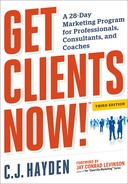Recipe: Follow-Up Mailings
Whenever you meet someone at a live networking event or elsewhere who is not an immediate prospect, an easy and inexpensive way to follow up immediately is to send a nice-to-meet-you note by postal mail or e-mail. Depending on the nature of the contact, you might include an interesting article or your brochure or fact sheet, or point the person to your website. Then add the person to your contact management system for later follow-up.
In addition, if you are actively engaged in social media, you might also add people you meet to your network by requesting to connect or following them. And, when you have their permission, you might also add them to your broadcast e-mail system, if you have one. See the following sections on “Following Up by E-mail” and “Following Up with Social Media and Online Communities” for more on these topics.
As you work to fill the pipeline, you will constantly be collecting names and addresses of people you have met or spoken with, which you will be capturing in your contact management system and/or your broadcast e-mail system. These people will make up your in-house mailing list. When your list reaches about 300 names, consider sending your list some kind of mail or e-mail on a regular basis. This mail to your in-house list is for the purpose of following up with people you already know to remind them of your services and continue building your relationship with them. It’s very different from direct mail or bulk e-mail sent to strangers on a prospect list that you bought or compiled.
With hot prospects, frequent referrers, and current clients, you will want to be in contact often, perhaps even monthly. In addition to phone calls, meetings, and interacting online, you might send these special people personal notes or cards by e-mail or mail, as well as articles of interest, links to useful websites, or invitations to upcoming events.
With your larger list of warm or cool prospects, referral partners, and past clients, sending a mailing three to four times per year is often sufficient to keep your name visible. You could opt for a simple postal mail piece like a postcard or mailer, or put more effort into publishing your own newsletter or e-zine.
Postcards, self-mailers, and other small pieces sent by postal mail often take the form of reminders or announcements with an attention-getting tag line and graphic. Here are some examples:
Overloaded with year-end work? Time to call Rodney Chen.
Sales in a slump? Take Charge Marketing can help.
January special—bring a friend and your next appointment is free!
Now serving Sonoma County! Call for an appointment today.
Keep the amount of text to a minimum. A mailer is not intended to do the job of a brochure. What you want is for the recipients to contact you with their questions, not get all the information they need from your mailer.
Producing a print newsletter can be a sizeable job, requiring skills on several levels: how-to writing for articles, copywriting for promotional sections, and graphic design for art and layout. If your skills in these areas are limited, get some professional help, especially with design. Homemade newsletters usually look it, and there’s no point putting in this much time and money if your prospects won’t be impressed.
A print newsletter can be as few as two pages or as many as eight. Typical contents include one or more informative articles aimed at your market niche, interspersed with several shorter items sharing news, resources, or inspiration. Be sure your newsletter contains more useful information than it does promotional copy. Ideally, you want the people on your mailing list not only to read your newsletter but to pass it along to friends as a helpful resource.
Instead of a print newsletter, you might choose to use an e-zine, and there’s more about that in the next section. But despite its higher expense, a print newsletter can be an effective choice with prospects who will pay more attention to postal mail than to e-mail. This can include both people who don’t use e-mail much and those who get far too much e-mail already. A print newsletter can also be used as a marketing piece that you distribute at speaking engagements or networking events, hand out at trade shows, or include in your marketing kit.
